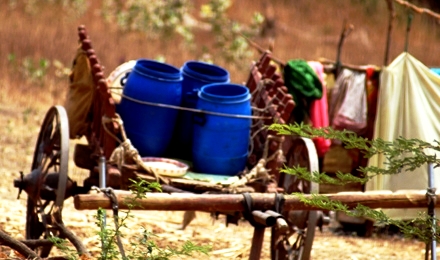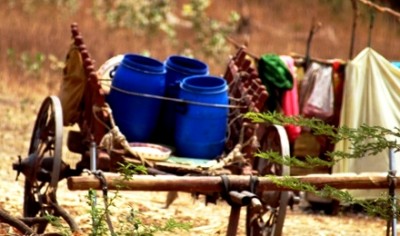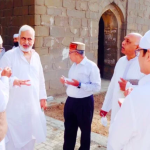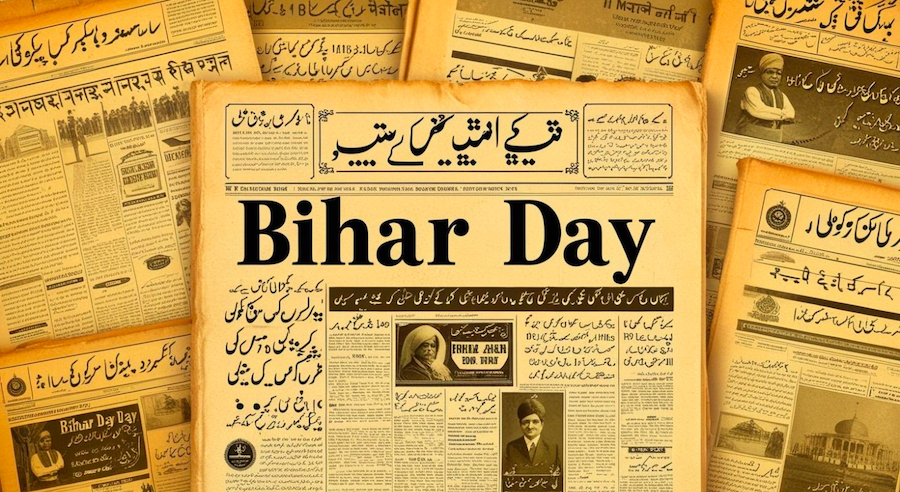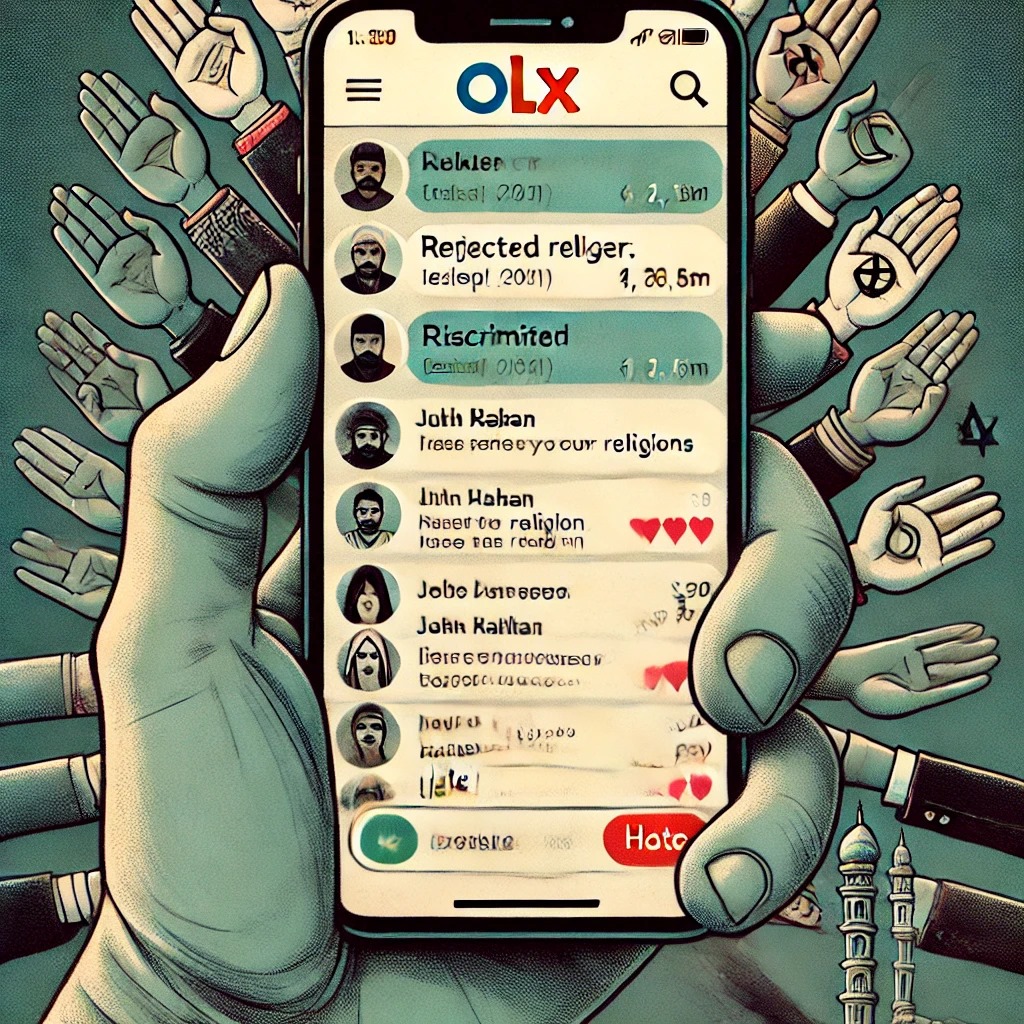Abhishek Srivastava from Aurangabad
“I remember the Manipal meeting most of all for a talk on the last day by the Mysore-based writer Devanur Mahadeva. Mahedeva began by reading out a short poem in Kannada, written not by him but by a Dalit woman of his acquaintance. The poem spoke reverentially of the great Dalit leader B. R. Ambedkar (1889–1956), and, especially, of the dark blue suit that Ambedkar invariably wore in the last three decades of his life. Why did the Dalit lady focus on Ambedkar’s suit, asked Mahadeva? If Ambedkar had worn a dhoti, went on Mahadeva, that would not occasion wonder or surprise. He is a Dalit, we would say—what else should he wear? Millions of his caste fellows wear nothing else. It is the fact that he escaped their fate that is symbolized in that suit.”
-Ramchandra Guha, “The Darlingofthedispossessed”(The Hindu, 08.12.2002)
I was in a fix. Since last two hours on the way to Paithan, I was witnessing a phenomenon, simply blue drums! Lined on the state highway for filling water from tankers, visibly put outside each and every home, installed on rooftops in line hotels, hanging dejectedly from bicycles and bullock carts, the same blue plastic drums. I asked our Dalit driver Kailash, “Why only blue drums here?” He smiles unknowingly with his typical dark Marathi face on windscreen, “I don’t know… but yes, it’s true!” Welcome to Marathwada, the world of unending blues. This is 14th day of April and 122nd birthday of “Vishwaratan” Babasaheb Ambedkar, as the infinite blue banners and hoardings speak of him everywhere and anywhere amidst what is being told as the greatest famine after 1972 affecting 3905 villages in 12 districts of Marathwada.
It’s an interesting analogy although somewhat misplaced, if at all. If Ambedkar had “escaped the fate of Dalits that is symbolized in his blue suit”, so the people with blue drums who have escaped the fangs of death at least till now. So blue rescues from the blues! Isn’t it? Kailash may not be well versed with all this metaphor, yet he gives a clue, “Last week when people had gathered in city (Aurangabad) from nearby villages for monthly haat (market), someeight buffaloes died of thirst… all due to the inaction of Ajit Pawar and likes.” “So who will you vote for in the upcoming elections?” There comes the prompt reply, “Shiv Sena”. And this is not just Kailash, it represents 20 percent of this area’s Dalit voice of whom almost 85 percent are agricultural labors seen nowhere nowadays in the ochre barren fields.
As we head towards Jayakwadi, the largest earthen dam of this region, we come across a leaking water tanker just waiting outside the gate of Garware Polyester. Milind, another Dalit from Piparwadi village tells us that industries here do get regular supply of water from the dam directly and government tankers are only meant for the people. So what this tanker is waiting for? Obviously not for the people at least. Thre are three filling points on the way to Paithan (taluka where Jayakwadi is situated) from Aurangabad all run by Aurangabad Municipal Corporation. An average 25-30 tankers are filled daily at each point, each having a capacity of 12000 litres. Every village gets two tankers daily irrespective of its size and populace leaving people like Milind sitting on the boundary wall of filling stations waiting for something to leak out accidentally and fill their blue drums.
 As if this is not enough, a small locality named Lasur on Manmad-Aurangabad rail route just 20 minutes back gets a tanker twice a week. Jayanti has appeared in B.Com final year exams this month and she is on the way to “city” (Aurangabad) by Shirdi-Secunderabad Express with her mother, father, small sister, grandpa and leaning grandma, who needs to be admitted to a hospital having regular water supply. Lasur has some small nursing homes with almost all non-functional due to water shortage. She tells us that water has never been at the mark of “development” in this area although this year has brought handful of woes. They store whatever they could get from the twice a week tanker and rest is the story of loot and greed. Kailash opens the case, “Each village is supposed to get four tankers but the government officials only send two and the rest are blackmarketed.” Now, if we could make out the simple mathematics: if 100 municipal tankers are filled daily at three municipal filling points between Aurangabad and Paithan, 50 are blackmarketed, then the total water being sold illegally in just 50 kilometres stretch (Aurangabad to Paithan is 53 kilometres) comes out to be six lakh litres! The tanker waiting outside Garware Polyester is obviously no mystery.
As if this is not enough, a small locality named Lasur on Manmad-Aurangabad rail route just 20 minutes back gets a tanker twice a week. Jayanti has appeared in B.Com final year exams this month and she is on the way to “city” (Aurangabad) by Shirdi-Secunderabad Express with her mother, father, small sister, grandpa and leaning grandma, who needs to be admitted to a hospital having regular water supply. Lasur has some small nursing homes with almost all non-functional due to water shortage. She tells us that water has never been at the mark of “development” in this area although this year has brought handful of woes. They store whatever they could get from the twice a week tanker and rest is the story of loot and greed. Kailash opens the case, “Each village is supposed to get four tankers but the government officials only send two and the rest are blackmarketed.” Now, if we could make out the simple mathematics: if 100 municipal tankers are filled daily at three municipal filling points between Aurangabad and Paithan, 50 are blackmarketed, then the total water being sold illegally in just 50 kilometres stretch (Aurangabad to Paithan is 53 kilometres) comes out to be six lakh litres! The tanker waiting outside Garware Polyester is obviously no mystery.So Milind’s blue drum may see an endless wait today, although he is not ready to spare time after 5.00 p.m. as he has to go for a march and function with his family. He says, “Babasaheb ko jaante hain aap? Kitaab mein padha hoga? Bahut mahaan aadmi the, aaj unka jayanti hai.” Kailash is also eager to return before six in the evening so he drives us fast to Jayakwadi Dam, walls of which are painted with the name Nath Sagar, popular name of the reservoir. It’s a huge expanse of water at the first sight with people bathing and diving on its banks. A newcomer may not be able to make the sense out of Ajit Pawar “urine” statement as there is much water visible to challenge the Pawar clan’s urinating capacity and legitimacy. Although visibility is one thing that may not reflect the real intentions, as with the case of Pawar’s day long repentance fast. We ask one Mr. Namdeo to explain the situation who has been here at the dam for last 25 years. He tells us that the visible part of a huge green pasture amidst reservoir waters is the unique scene witnessed otherwise water was always more or less up to mark. “This is due to shortage of rainfall”, he says.
Interestingly no commoner referred to water diversion that is being talked of in media nowadays. On the contrary, some seemed to justify regular water supply to industries like Mr. Bisht, who had left his home district Pithauragarh in Kumaon, Uttarakhand way back in 1978 and is now settled in Aurangabad as a caterer. Bisht says, “There was nothing in Aurangabad thirty years back. Whatever you have heard of this city, like Mercedez order etc. is the result of industrialisation only. Just forget who owns these industries, but if you don’t give water to them, it will be blunder.” He is referring to the single largest order of 150 cars worth Rs 65 crore to Mercedez Benz in 2010, that brought global media attention to Aurangabad. The historic moment was claimed in the following words, “Aurangabad has everything and is an economic powerhouse, but investors are still scared of coming here due to its perceived negative image, which we decided to change forever,” said Sachin Mulay, president of the Chamber of Marathwada Industries and Agriculture in 2010. However, this “economic powerhouse” is now running on a pittance from the freshly dug up borewells in barren cotton fields and whatever has been left in the Jayakwadi dam.
 On the darker side however, people have something to cheer up about. No water, not much problem. You can have a juicy mid-sized watermelon in just ten rupee or cucumbers in Jayakwadi weekly haat. You can see heaps of empty beer bottles at the back of a roadside “permit room and beer bar” in Shegaon and farmers busy in chat over a drink when the mercury is touching 40 degree celsius! Back to city,women dressed in bright red-green sarisand men in their white shirts line up outside the Indian Hotel in Peer Bazaar, a predominant muslim locality of Aurangabad. They are celebrating their hero’s birthday, children pouncing up on balloons and women licking ice-creams sticks. It’s just 9.00 p.m. and the famous Hyderabadi Biryani is out of stock. So is the charitably distributed free water on a police run stall. So what? You have much options nowadays. From Aurangabad to Ahmednagar, one could see variety of mineral water bottles hanging by thread outside small shanty shops. Kailash says, “Nahin latkayenge to pata kaise chalega ki paani hai”.
On the darker side however, people have something to cheer up about. No water, not much problem. You can have a juicy mid-sized watermelon in just ten rupee or cucumbers in Jayakwadi weekly haat. You can see heaps of empty beer bottles at the back of a roadside “permit room and beer bar” in Shegaon and farmers busy in chat over a drink when the mercury is touching 40 degree celsius! Back to city,women dressed in bright red-green sarisand men in their white shirts line up outside the Indian Hotel in Peer Bazaar, a predominant muslim locality of Aurangabad. They are celebrating their hero’s birthday, children pouncing up on balloons and women licking ice-creams sticks. It’s just 9.00 p.m. and the famous Hyderabadi Biryani is out of stock. So is the charitably distributed free water on a police run stall. So what? You have much options nowadays. From Aurangabad to Ahmednagar, one could see variety of mineral water bottles hanging by thread outside small shanty shops. Kailash says, “Nahin latkayenge to pata kaise chalega ki paani hai”.He is right. In the playground of Videocon, Bajaj, Audi, Skoda, Garware and the likes, survival lies in knowing and identifying where the water is. Where there is water, there is money. Money could buy more water, if not then beer! And where there is none, still the drum beats for “Jai Bheem”. Some serious blue sky thinking needed! (Courtesy: Pratirodh)

